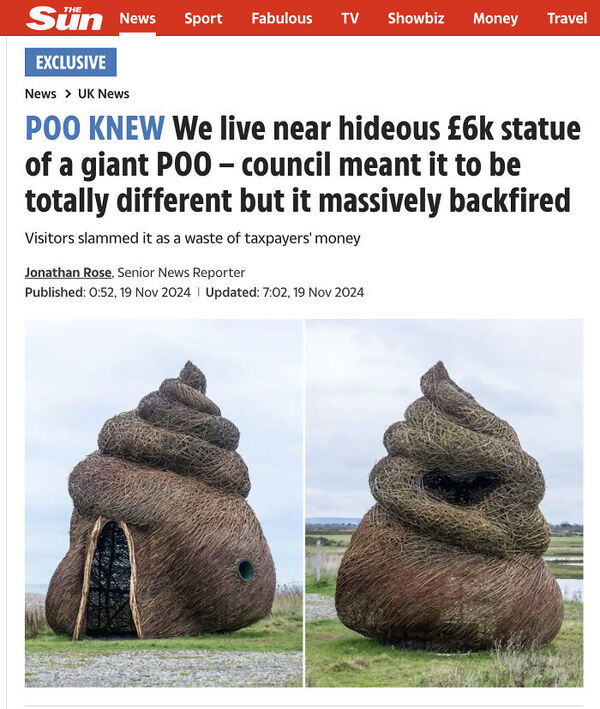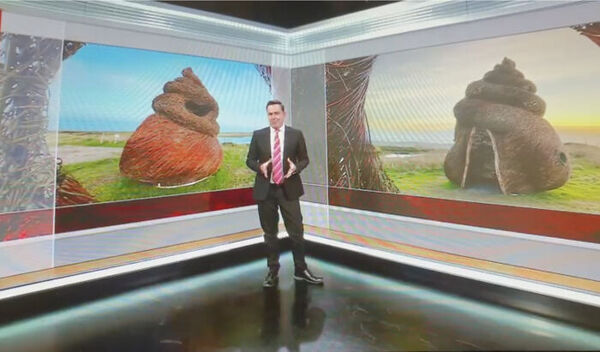In 2024, a new public art sculpture titled Primrose Shelter has stirred intense controversy among locals. Standing at 15 feet tall, this spiral-shaped structure is part of a project to commemorate the rich coastal heritage of Bracklesham Bay, near Chichester. However, instead of receiving praise for its artistic message, it has been likened to a "giant poop emoji," causing a stir in the community.

The £6,000 sculpture, which resides at the Medmerry Nature Reserve, is part of one of Europe's largest coastal rewilding projects. The project’s aim is to restore the local ecosystem, but the sculpture itself has drawn sharp criticism for its unconventional design. In response to the backlash, artists Mark and Rebecca Ford, the creators of the piece, commented, "Art can be controversial, and things can be ambiguous." They emphasized that while the sculpture may initially seem unpleasant or simplistic, its true meaning goes much deeper.
The conical shape of the Primrose Shelter is far from just a visual gimmick. The design is intended to symbolize the natural elements of the area and the human connection to the environment. According to Rebecca Ford, the structure evokes the imagery of a sea snail shell, a nod to the Bronze Age. The shape is specifically inspired by a discovery during an agricultural dig in the nature reserve, where snail shells were found inside fish baskets that date back to around 1100 BCE. This connection between past and present forms the backbone of the sculpture’s historical significance.
Made from woven willow branches, the Primrose Shelter incorporates an organic medium that reflects the surrounding salt marshes and mudflats. This use of natural materials brings to mind the land art of Robert Smithson and Richard Long, as well as the growing awareness of climate change. The piece also aligns with Frank Lloyd Wright's “organic architecture” philosophy, which advocates for harmony between human beings and the natural world. In a similar manner, the Primrose Shelter serves as a visual and functional metaphor for the relationship between humanity and its habitat.

Visitors to the sculpture are invited to step inside and observe the world around them through "cloud windows," which feature silhouettes of marsh hares and raptors. This immersive experience encourages reflection on the natural environment, echoing Wright’s idea that we should “study nature, love nature, and stay close to nature.” Rebecca Ford also highlights a deeper layer of the work, particularly in relation to climate change. She points out that if people see the shape of feces in the sculpture, it may act as a metaphor for the damage we are doing to our coastlines, as if we are recklessly allowing waste to spill into the natural world.
The Primrose Shelter also evokes memories of 1960s and '70s conceptual art movements, especially Earth Art, which used only natural materials or the earth itself as the medium. In a way, the landscape becomes the artist’s canvas, and their hands are the brushes. The use of raw, ever-changing materials contrasts sharply with expensive man-made objects, prompting viewers to reflect on the marks they leave and their primal connection to the Earth. Could the shelter even be seen as a subtle reminder of mortality, a symbol of death in Christian tradition?
Despite the controversy, the Primrose Shelter continues to attract visitors who want to immerse themselves in the local environment and embrace its rich history and natural beauty. In response to the critics, Mark Ford invited skeptics to "come to the nature reserve, sit inside the Primrose Shelter, and form their own opinions." So, what do you think when you glance at the screen? Feces or genius? You decide.
animal tags: primrose-shelter